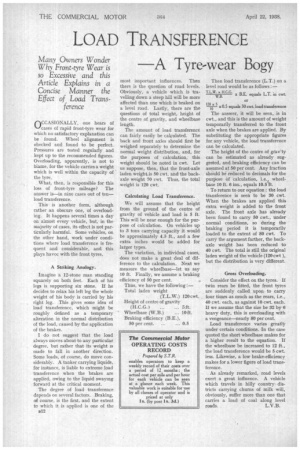LOAD TRANSFERENCE A Tyre-wear Bogy
Page 46

If you've noticed an error in this article please click here to report it so we can fix it.
OCCASIONALLY, one hears of N/cases of rapid front-tyre wear for which no satisfactory explanation can be found. Wheel alignment is checked and found to be perfect. Pressures are tested regularly and kept up to the recommended figures. Overloading, apparently, is not to blame, for the vehicle carries a weight which is well within the capacity of the tyre.
What, then, is responsible for this loss of front-tyre mileage ? The answer is—in nine cases out of ten— load transference.
This is another form, although rather an obscure one, of overloading. It happens several times a day on almost every vehicle, but, in the majority of cases, its effect is not particularly harmful. Some vehicles, on the other hand, work under conditions where load transference is frequent and considerable, and this plays havoc with the front tyres, A Striking Analogy.
Imagine a 12-stone man standing squarely on both feet. Each of his legs is supporting six stone. If he decides to relax his left leg the whole weight of his body is carried by his right leg. This gives some idea of load transference, which might he roughly defined as a temporary alteration in the normal distribution of the load, caused by the application of the brakes.
I do not suggest that the load always moves about to any particular degree, but rather that its weight is made to fall in another direction. Some loads, of course, do move considerably. A tanker carrying liquids, for instance, is liable to extreme load transference when the brakes are applied, owing to the liquid swaying forward at the critical moment.
The degree of load transference depends on several factors. Braking, of course, is the first, and the extent to which it is applied is one of the 131.2
most important influences. Then there is the question of road levels. Obviously, a vehicle which is travelling down a steep hill will be more affected than one which is braked on a level road. Lastly, there are the questions of total weight, height of the centre of gravity, and wheelbase length.
The amount of load transference• can fairly easily be calculated. The back and front axles should first be weighed separately to determine the normal weight distribution, and, for the purposes of calculation, this weight should be noted in cwt. Let us suppose, then, that the front-axle laden weight is 50 cwt. and the backaxle weight 70 cwt. Thus, the total weight is 120 cwt.
Calculating Load Transference.
We will assume that the height from the ground of the centre of gravity of vehicle and load is 5 ft. This will be near enough for the purpose of calculation. On vehicles up to 3 tons carrying capacity it would be approximately 4.5 ft., and a few extra inches would be added for larger types.
The variation, in individual cases, does not make a great deal of difference to the calculation. Next we measure the wheelbase—let us say 10 ft. Finally, we assume a braking efficiency of 50 per cent.
Thus, we have the following :— Total laden weight (T.L.W.) 120 cwt. Height of centre of gravity (H.C.G.) 5 ft.
Wheelbase (W.B.) ... 10ft. Braking efficiency (B.E.), 50 per cent. ... ... 0.5 Then load transference (L.T.) on a level road would be as follows :— W.B. x B.E. equals L.T. m cwt.
or
120 x 5 x 0.5 equals 30 cwt. loadtransferenee The answer, it will be seen, is in cwt., and this is the amount of weight temporarily transferred to the front axle when the brakes are applied. By substituting the appropriate figures for any vehicle, the load transference can be calculated.
The height of the centre of grav'ty can be estimated as already suggested, and braking efficiency can be assumed at 50 per cent. Any fraction should be reduced to decimals for the purpose Of calculation, i.e., wheelbase 10 ft. 6 ins., equals I0.51t.
• To return to our equation : the load transference is seen to be 30 cwt. When the brakes are applied this extra weight is added to the front axle. The front axle has already been found to carry 50 cwt., under normal conditions, so during the braking period it is temporarily loaded to the extent of 80 cwt. To carry the argument farther, the backaxle weight has been reduced to 40 cwt. The total is still the original laden weight of the vehicle (120 cwt ), but the distribution is very different.
Gross Overloading.
• Consider the effect on the tyres. If twin rears be fitted, the front tyres are suddenly called upon to carry four times as much as the rears, i.e., 40 cwt. each, as against 10 cwt. each. If we assume that the size be 32 by 6 heavy duty, this is overloading with a vengeance—nearly 80 per cent.
Load transference varies greatly under certain conditions. In the case quoted the short wheelbase makes for a higher result to the equation. If the wheelbase be increased to 12 ft., the load transference would be 5 cwt. less. Likewise, a low brake-efficiency makes for a lower figure of load transference.
As already remarked, road levels exert a great influence. A vehicle which travels in hilly country districts carrying churns of milk will, obviously, suffer more than one that carries a load of coal along level roads. L.V.B.


































































































